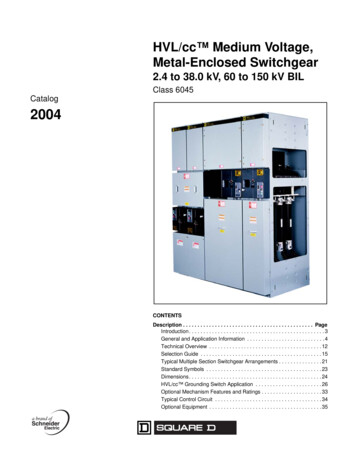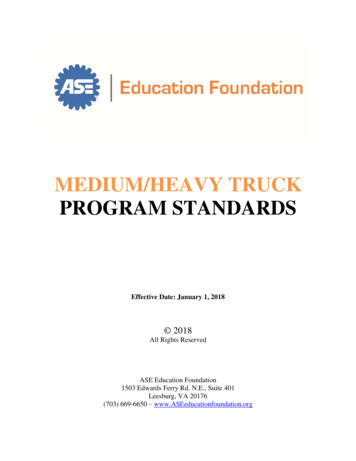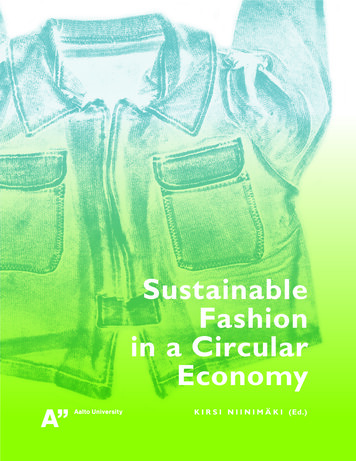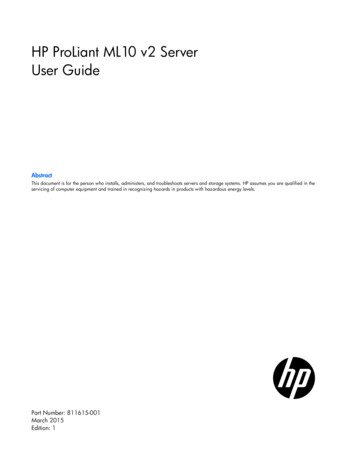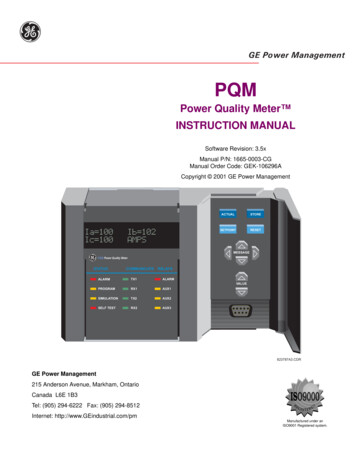
Transcription
SUSTAINABILITYThe circularity ofmedium-powerelectrical transformersEvaluating design options based on anin-depth market surveyABSTRACTThe Design-for-recycling of mediumpower transformers is complicatedby their long lifetimes. What will therecycling markets and technologieslook like 50 years from now? Wemust be content with basing longterm predictions on the present-24day situation. The Copper Allianceconducted an in-depth survey of thecurrent state of transformer recycling.With their high metal content andstraightforward disassembly, liquidfilled transformers score highly interms of circularity. This can befurther enhanced by using copper forthe high voltage winding. Dry-typetransformers are a different story;the lack of separability leads to aproblematic end-of-life process.KEYWORDSrecycling, design-for-recycling,circularity, copper windings, dry-typetransformersTRANSFORMERS MAGAZINE Volume 9, Issue 1 2022
Bruno DE WACHTER, Tomas JEZDINSKY1. IntroductionIn its Green Deal and the new CircularEconomy Action Plan, the EU has beenemphasising that the energy transitionshould be accomplished with maximumresource efficiency. The revised Methodology for Ecodesign of Energy-relatedProducts (MEErP), published in July2021, translated this ambition into concrete decision-making instruments promoting the systematic assessment of material efficiency and recyclability in productdesign. The present article focuses ondesign-for-recycling for medium-powertransformers.A first major observation is that medium-power transformers remain in usefor a very long time. The depreciationperiod is typically 40 years, but their actual lifetime can be much longer — usu-EU’s Green Deal and the new Circular Economy Action Plan emphasise that the energy transition should be accomplished withmaximum resource efficiencyally more than 50 years and sometimeseven 80 years [1]. This long lifetime is amajor strength in terms of material efficiency but comes with the complicationthat long-term recyclability assessmentis a challenge. It is impossible to accurately predict where recycling markets,technologies, and regulations will stand50 years from now. We have to make dowith rough assessments based on today’smarket and technology, keeping in mindthat the results should be viewed in lightof an uncertain future.With this goal in mind, the Copper Alliancecarried out an in-depth survey of thecurrent state of transformer recycling,conducting interviews at 20 stakeholdercompanies in Germany, Spain, Italy,France, and Serbia (a full list of theinterviewed companies can be foundin [2]). The data collected in the surveywere processed and approved followingthe Delphi method. All statements inthe chapters that follow in this article arebased on the survey results, except whereotherwise indicated.Around 70 % of the transformer’s mineral oil is recycled as firstgrade for reuse in transformers, and the remaining 30 % is reused assecond-grade oil in other applications — mainly as an industriallubricantw w w . t ra n sfo r m e r s - m a g a z i n e . co m25
SUSTAINABILITYThe windings recycling requires shreddingto filter out the small amounts of impregnated paper and lacquer, after which theycan be almost 100 % recovered2. The recycling of liquid-filledtransformersIn recent times, end-of-life liquid-filledtransformers have received major attention because of the presence of PCBs,which were judged toxic and banned bythe EU in 1987. A positive consequenceof the PCB crisis is that now only certifiedcompanies are allowed to handle oil-filledtransformer recycling.esters could, in principle, be recovered inthe same way as mineral oil, but there isno first-grade recycling process for natural esters yet because the market, equipment, and technical standards to cover itare lacking. An estimated 20–30 % of natural ester insulation is currently subject tosecond-grade recycling as vegetable oil,while the remainder goes for incinerationwith heat recuperation. A more efficientmarket for natural ester recycling and reuse is expected to develop as more of thesetransformers reach end-of-life.(Alu 7), which is the required level forreuse in new aluminium electrical wiremanufacturing. In practice, however, thefact that it exists in many different alloys poses a serious barrier. The materialshould be subjected to laboratory analysisto detect the alloys and could then be recycled for use only in exactly the same kindof electrical application as previously. Thisis technically and organizationally complicated and is never carried out in practice. Because of the presence of the alloymaterials and other contaminating metals(e.g., copper from connectors), the puritylevels of the aluminium from transformerwindings do not get any higher than 98 %.Therefore, the material is downgraded foruse in second-life products for which thispurity level is sufficient, such as buildingmaterials or non-electrical automotiveparts.As a first step in the recycling process,the oil is analysed and pumped out ofthe transformer. Mineral transformer oil In the next stage, the windings are removed Where high voltage windings are made ofTO ENJOY FULL ACCESS TO THE TEXT, GET THEcould, in principle, be recovered entirely from the transformer and shredded to fil- copper, the winding shreds are recycled atONLINEFULLOR DIGITALSource:UNand GouldenAnalysisthree different purity levels.through a filtering process. In practice,ter however, around 70 % of the oil is recypaper and lacquer. The shredded metals Purity level 1A ( 99.9 %) has the samecled as first-grade for reuse in transform- can be almost 100 % recovered.quality as copper cathodes. It can beers, and the remaining 30 % is reused asmelted and used again for electricalsecond-grade oil in other applications — The aluminium could, in theory, be reapplications, including transformermainly as an industrial lubricant. Natural cycled with purity levels of up to 99.7 %windings, without further purification.This means that it follows a truly circular route that is highly efficient in termsof cost, energy use and environmentalimpact. Purity level 1B ( 99.7 %) has the samequality as copper anodes. It must besubjected to an electrolysis process toreach the purity level required for electrical copper. Purity level 2 ( 95.0 %) has the samequality as the copper concentrate soldby mining companies. It would needto undergo a thermo-chemical processto reach level 1B, and subsequently besubjected to an electrolysis process toreach level 1A, the purity level requiredfor the electrical copper. In practice,it rarely follows this trajectory and isused without further purification inapplications that require lower purity,such as copper alloys (e.g., brass) or additives in steel making.Figure 1. Coils in the production line of three-phase oil-filled distribution transformers26How much of the copper exactly goes intoeach of those purity levels depends on therecycling company, but most ( 90 %) willbe recycled at level 1A. One company hasstated that it recycles 97 % of the copperfrom transformer windings at the highestpurity.TRANSFORMERS MAGAZINE Volume 9, Issue 1 2022
Magnetic steel from the transformer coreand structural steel parts are almost 100 %recovered. Magnetic steel laminates can, inprinciple, be cleaned and reused in a newtransformer. However, the transformerscurrently being taken out of service in theEU have laminate thicknesses of 0.3 mmand above, which no longer comply withthe current Ecodesign regulation. Somego to be stamped out to make laminatesin Asia and Turkey, where smaller transformers are not subject to loss restrictions[3]. The process of stamping out smallerlaminates from the original piece also hasthe advantage that potential damage fromthe dismantling process at the laminateedges is not an issue. The proportion ofmagnetic steel following this route depends on prices in the Asian market.Porcelain elements used for electricalinsulation in various parts of the transformer are sorted, cleaned and shredded.Almost 100 % is used in construction,mainly as hardcore in road construction.About 3–5 % of a transformer is organicmaterial such as wood, paper, or corrugated cardboard. Much of this has beenimpregnated with oil by transformer endof-life. This liquid could, in principle, beseparated from the solid waste for reuse,but this is not economically viable. As a result, these materials, with the oil they contain, go to waste incineration plants withenergy recovery. This means that they areused as a combustion material to generateheat or electricity. In some EU countries,a lack of incineration plants or legal constraints means that these elements end upin the landfill.A small proportion of the transformer(1–2 %) cannot be reused, recycled, or incinerated and has to be disposed of in thelandfill. This includes plastic joints andbuffers and silica connectors.Table 1 illustrates typical recycling and circularity levels for a 400 kVA distributiontransformer containing PCB-free mineraloil, M0H magnetic steel, aluminium lowvoltage winding, and either aluminium orcopper for the high voltage winding.3. The recycling of dry-typetransformersCast-resin dry-type transformers pose amajor difficulty for recycling. The windings, which in the case of oil-filled transw w w . t ra n sfo r m e r s - m a g a z i n e . co mFigure 2. Copper granulates at a recycling plantMagnetic steel from the transformer coreand structural steel parts are almost 100 %recovered, and magnetic steel laminatescan, in principle, be cleaned and reused in anew transformerformers can be extracted easily and recycled, are entirely over-moulded withan epoxy or quartz resin. Separating thisresin from the metal coils takes time andenergy and is not economically viablewithin the EU. It would require powerfulmachines for pre-cutting the material intosmaller pieces (typically 1000 kN) andseveral rounds of milling and grindingwith high-powered shredders (typically4500 kN). Even then, the metal can onlybe recovered at low purity ( 95 %) for useonly in secondary applications. Moreover,more than 80 % of dry-type transformers use aluminium as a winding materialrather than copper, which limits the scrap’seconomic value. If separation were possible, the economically worthless resin partswould still make up about 40–50 % of thematerial weight in the case of aluminiumwindings and 30–40 % of the materialweight in the case of copper windings.Since the resins are chemically diverse andrecycling is highly complex, they cannotbe recovered and have to be disposed of inthe landfill.These findings are supported in an Italian University thesis [4] which states thatfull separation of the resin and coil todayis “highly costly, time-consuming and aneconomic nonsense”. Even the special27
SUSTAINABILITYAbout 3–5 % of a transformer is organic material such as wood, paper, orcorrugated cardboard, mostly going to waste since it is not economicalto reuse itised cryo-grinding process is not seen asa solution according to the thesis since itwould require an excessive quantity ofliquid nitrogen for the separation (120 litres of liquid nitrogen to recover 300 kg ofresin).As a result, the coils still entirely coveredwith cast resin are sold together with other electromechanical scraps for exportoutside the EU. It is assumed that most ofthem end up in India, where a low-paidworkforce separates the resin from themetal coils in semi-automated processes.The recovered metal is sold to foundries aslow-grade scrap, with the remainder ending up in the landfill.Figure 3. Transformer magnetic steel laminatesOther parts of cast-resin dry-type transformers, including the magnetic steel inthe core, structural steel parts in the frame,and ceramic components, follow the samerecycling path as in the case of liquid-filledtransformers.ConclusionThe circularity assessment of medium-power electrical transformers isstriking for the sharp contrast betweenliquid-filled and dry-type units. The firstsets the example, with its straightforwarddisassembly and a high degree of recyclability, while the second shows how alack of separability in the conception of adevice can lead to a problematic end-oflife process. Their application areas partlyoverlap, so there is often a choice betweenthe two types, and, until now, circularityhas seldom been a decisive argument inmaking this choice. With increasing attention on the circular economy in businessand policy-making, this is soon likely tochange.Figure 4. A new cast-resin dry type transformerIn the case of oil-filled transformers, about75 % of the material can be reused or isCast-resin dry-type transformers are difficult to recycle since theirwindings are entirely over-moulded with an epoxy or quartz resin, andtheir separation requires time and energy that is not economically viablewithin the EU28TRANSFORMERS MAGAZINE Volume 9, Issue 1 2022
Table 1. Typical recycling and circularity levels fora 400 kVA transformerEnd‐of‐life material400 kVA, M0H, mineral oil,aluminium in HV windingkg2nd grade recycling (non‐circular)AluminiumMineral oil 2nd grade (30%)Copper 2nd grade (5%)PorcelainIncineration with energy recuperationWood, paper, cardboardLand‐fill disposalOther parts (kg)Total weight (kg)kg76%Re‐use and 1st grade recycling (circular)Magnetic steelMineral oil 1st grade (70%)Copper 1st grade (95%)Structural steel%400 kVA, M0H, mineral oil, copperin HV 19%11%10%6%0%1%131%5%2%2%100%6029862%100%It is assumed that most windings from cast-resin dry-type transformersend up in India, where a low-paid workforce separates the resin from themetal coils in semi-automated processessubject to first-grade recycling. Its degreeof circularity can be enhanced furtherwhen copper is used for the high voltagewinding because the metal can be recuperated and recycled at high purity. Copper windings also increase the end-of-lifevalue of the unit, enhancing the businesscase for recycling and reuse.Bibliography[1] Circular Economy: Contributionto material efficiency applied to transformers, T&D Europe Position Paper,2018[2] B. De Wachter, T. Jezdinsky, Medium-power transformer recyclability,European Copper Institute, 2021[3] V. Pillai, CRGO Issues Still HauntTransformer Industry, T&D India, 2018[4] M. G. Scevola, A. Baggini, Trasformatori di potenza MT/BT: Analisidell’impatto sul fine vita delle carateristiche costruttive in contesto dieconomia circolare, Universitá di Pavia,2020w w w . t ra n sfo r m e r s - m a g a z i n e . co mAuthorsBruno De Wachter has 25 years of experience as a freelance engineer-copywriter in B2B and EU advocacy communication. He combines his technical background witha passion for employing precise forms of expression andwide-ranging knowledge of the energy transition and policy-making on sustainability issues. He has a master’s degreein Electrical Engineering (UGent) and a post-master’s inEuropean languages and literature (University of Antwerp). A native Dutch speaker, Bruno is fluent in English, French, German andSpanish. Since 2011 he has been an in-house consultant and copywriter for theEuropean Copper Institute on topics related to renewable energy systems, transformers, motors, energy management, wiring in buildings, and electrical safety.Tomas Jezdinsky has over 25 years of experience as atechnical b2b market research project manager. As a freelance consultant, he has conducted numerous marketanalyses since 2009 in areas such as energy generationand distribution, renewables, electrical machinery, ande-mobility. He has conducted several hundred in-depthexpert interviews and run focus groups in Europe, LatinAmerica and the USA. He has a master’s degree in philology / human arts and has an extensive technical background through years ofstudy in applied physics. A native German speaker, Tomas is fluent in English,French, Spanish and Italian. In recent years he has been involved in severalHorizon2020 projects as an in-house consultant for the European Copper Institute on topics related to energy efficiency and e-mobility.29
electrical transformers Evaluating design options based on an in-depth market survey ABSTRACT The Design-for-recycling of medium-power transformers is complicated by their long lifetimes. What will the recycling markets and technologies look like 50 years from now? We must be content with b



